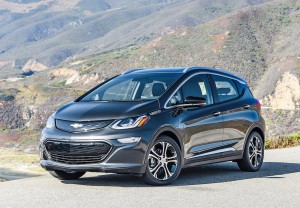
The Chevrolet Bolt was named Motor Trend's Car of the Year and is also a finalist for the North American Car of the Year.
Fresh off of a much-needed win as Motor Trend Car of the Year, the Chevrolet Bolt picked up some fresh momentum today, landing as one of three finalists for North American Car of the Year.
The long-range, mainstream-priced battery-electric vehicle will square off against the new Genesis G90 and Volvo S90 sedans, it was announced during a ceremony marking the start of the annual Los Angeles Auto Show.
NACTOY jurors also weighed in with their picks for North American Truck of the Year, as well as North American Utility Vehicle of the Year. The winners in all three categories will be announced during the opening event at the North American International Auto Show in Detroit on Jan. 9.
More than 50 different all-new or heavily updated cars, trucks and crossovers were evaluated by the 60 U.S. and Canadian journalists who make up the NACTOY jury – a group that includes TheDetroitBureau.com publisher Paul A. Eisenstein. The awards program is the oldest in North America not affiliated with any specific publication.
(GM, Hyundai/Kia take lead as NACTOY list narrows. Click Here for the story.)
All three of the Car of the Year contenders have received widespread kudos. The Bolt is seen by many as a key to building interest in plug-based vehicles. At an EPA-rated 238 miles per charge, it can go nearly three times the distance of most of today’s electric vehicles, with the exception of the Tesla Models S and X. And at a base price of $37,495 – before factoring in a $7,500 federal tax credit, the new Bolt carries only a minimal price premium over similar, conventionally powered models.
The Genesis G90, meanwhile, is the flagship of Hyundai’s new luxury brand. It is meant to target such vaunted competitors as the Mercedes-Benz S-Class and BMW 7-Series, but at a fraction of the price. Meanwhile, the Volvo S90 is the Swedish brand’s new flagship. It shares the same underpinnings as the Volvo XC90 – which last January was named North American Truck/Utility of the Year.
(Click Here for details about Chevy Bolt taking Motor Trend’s COTY award.)
The utility segment is this year being spun off into its own category, a decision jurors felt necessary considering it is now the fastest growing niche in the American new vehicle market. The three finalists are:
- The Chrysler Pacifica, an all-new take on the classic minivan. It has grown sales in recent months, suggesting there’s life in a segment many thought was ready to fade out. A plug-in hybrid version of the Pacifica is just getting ready to launch, as well;
- The Jaguar F-Pace is the British maker’s first-ever sport-utility vehicle, offering a mix of roominess, off-road capabilities, solid performance and strong design, according to jurors;
- The Mazda CX-9, meanwhile, is the latest iteration of the Japanese automaker’s midsize SUV. It boasts plenty of room, good mileage and the latest iteration of Mazda’s Kodo design language.
Light trucks also have seen their sales surge since the U.S. auto industry began its recovery early in the decade. Pickups, in particular, make up one of the market’s largest individual segments. The three finalists include:
- The Ford Super Duty, which on Monday was named Motor Trend Truck of the Year. Like the light-duty Ford F-150 before it, the heavy-duty line-up this year migrates from a conventional steel body to a lighter, more fuel-efficient “aluminum-intensive body;
- The Honda Ridgeline is making its return for 2017 after several years off the market and targets the resurgent midsize pickup segment. Honda’s entry is unique in being a unibody, rather than a classic body-on-frame design, an approach delivering better mileage and on-road manners;
- The Nissan Titan could give the Japanese automaker a real boost, after years of struggle, in its quest to crack open the huge full-size truck segment. A medium-duty model debuted for 2016, with the new light-duty Titan rolling out.
The NACTOY jury will take their last of three rounds of votes in the coming weeks. Each vehicle is judged on a variety of variables, including styling, performance, handling, fuel economy, technology and value for the money.
